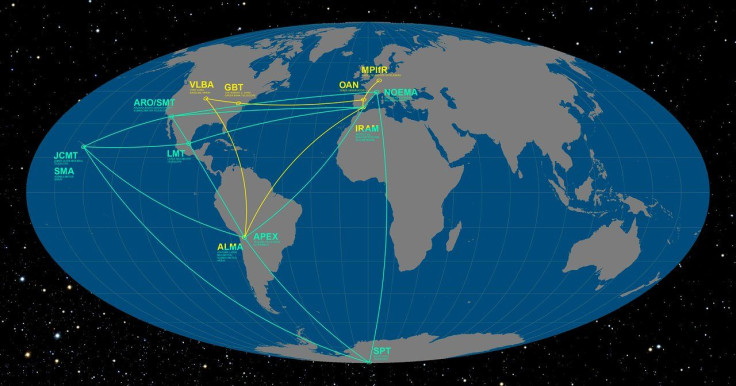Photographing Supermassive Black Holes: Earth-Size Event Horizon Telescope Starts Operation

There are a lot of things in the universe we don’t know much about, and among the most puzzling of those enigmatic objects are black holes. We know they have a very strong gravitational pull that doesn’t let even light escape, that they exist in varying sizes and sometimes in pairs, and we know that supermassive black holes are at the centers of many galaxies, but since direct observation of a black hole has never been possible, there is a whole lot more about them we are completely clueless about.
A new observation campaign that started Wednesday is trying to change that by making the first-ever images of the event horizon — the boundary beyond which any light coming from the black hole cannot escape — of Sagittarius A*, the supermassive black hole at the center of the Milky Way. The project, called the “Event Horizon Telescope,” uses eight large telescopes from around the world to create one large observational instrument. EHT will operate till April 14.
Read: How Did Supermassive Black Holes Form In The Very Early Universe?
The images that EHT will hopefully produce will be used to try determine the mass and spin of the event horizon of our central black hole, whose mass is 4 million times that of the sun. The distance of 26,000 light-years makes it so small from our point of view that it requires an Earth-size instrument to observe it.
EHT uses telescopes in Hawaii, Arizona, at the South Pole, in Chile, Mexico and Spain. According to a statement Wednesday by the University of Massachusetts, Amherst (UMass), that explains the project: “Using Earth’s rotation and aiming each telescope at the same object, over the course of many hours their sampled curves, combined, resemble the observational effect of one large instrument. The strategy of combining several telescopes to create a simulated larger dish area, known as Very Long Baseline Interferometry (VLBI), is not new. … It has been in use for decades, but this is the first time millimeter-wave VLBI to be undertaken on such a massive scale.”

UMass is one of the operators of the Large Millimeter Telescope in Mexico, which is one of the participating telescopes in EHT. Gopal Narayanan from the university said in the statement: “These are the observations that will help us to sort through all the wild theories about black holes. And there are many wild theories. With data from this project, we will understand things about black holes that we have never understood before.”
Data from EHT will also be used for other things, such as testing some notions in Einstein’s general theory of relativity. Given the extreme limits of physics that are at play in an event horizon, it would be the right place to test if general relativity and quantum mechanics can be brought together, Narayanan said.
Read: Gravitational Waves Kicked A Supermassive Black Hole Out Of Galactic Core
Along with Sagittarius A*, EHT will also image another supermassive black hole, one that sits in the center of Messier 87. It is a massive elliptical galaxy, one of the largest in the local universe, located about 53.5 million light-years away, and its central black hole is about 6 billion solar masses. Given its size, it has a much larger event horizon around it compared to the one at the center of the Milky Way, and therefore can perhaps be imaged despite the distance.
Among EHT’s other goals is to study the physics behind accretion and the creation of accretion disks, understanding plasma jets associated with central black holes, and maybe even explore the “information paradox” put forth by Stephen Hawking, which says matter falling into a black hole cannot disappear from the known universe.
© Copyright IBTimes 2024. All rights reserved.





















